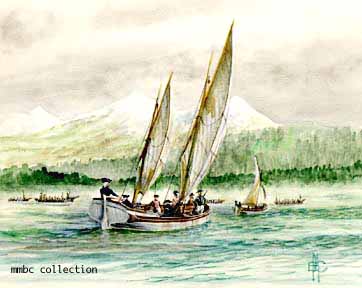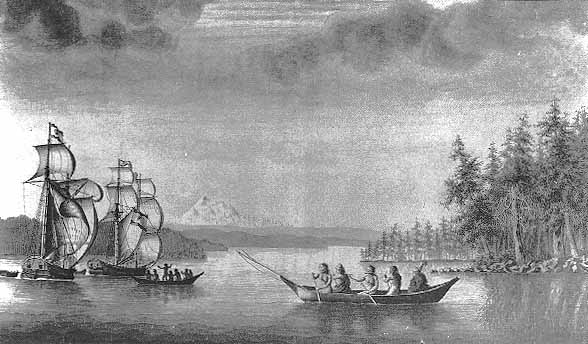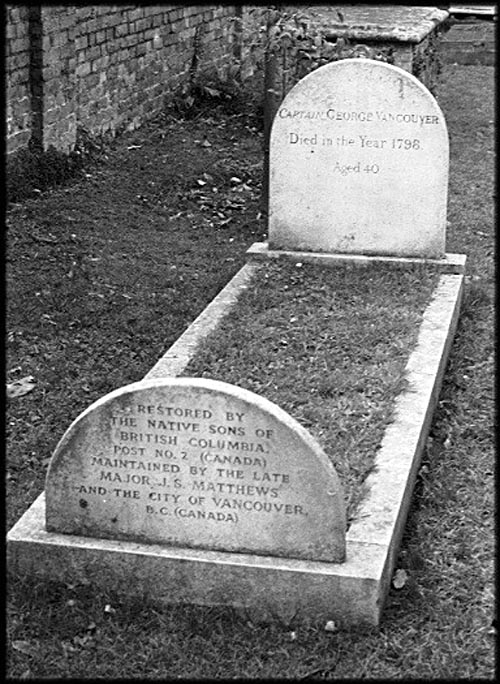
Bedwell Bay & Deep Cove –– View South From Buntzen Ridge

Bedwell Bay & Deep Cove –– View South From Buntzen Ridge
ARRIVAL OF THE EUROPEANS– By Diana Drake, Between Forest and Sea: Memories Of Belcarra, 1998.But for the fortunes of history and the tardiness of Captains Galiano and Valdez, Belcarra might well be situated today on the shores of Floridablanca Inlet or Canal de Sasamat.
Not that George Vancouver was an unimaginative man. Quite the contrary. Powdered, pudgy, bewigged though his portraits reveal him to be, he was by all accounts – especially his own – a disciplined, courageous spirit. Captivated by the haunting beauty of this land, he was both curious and intrigued by its native inhabitants. Of course he was also a man of his time. Neither he, nor the Spanish who followed, bothered to ask these same native inhabitants what they called the inlet that had been their home for over two millennia. Had they done so they would have learned it was Tsleil-Wautt or ‘People of the Inlet.’  The People of the Inlet first encountered George Vancouver just east of the First Narrows on June 13, 1792. It was a toss-up as to who was more intrigued with whom. Having left the relative safety of the Discovery and Chatham at anchor off Point Roberts and exploring now only in a launch and yawl, Vancouver's interest stemmed as much from perceived vulnerability as from curiosity. He wrote in his journal: “Here we met about fifty Indians in their canoes... We stood on under an easy sail, which encouraged them to attend us some little way up the arm... The major part of the canoes twice paddled forward, assembled before us and each time a conference was held... This sort of conduct always created a degree of suspicion and should ever be regarded with a watchful eye.”
Later that evening he made camp for the night somewhere near the junction of Burrard Inlet and the North Arm, now called Indian Arm, just south of Belcarra on the opposite shore. Landing at low tide on “shores formed by steep rocky cliff that afforded no convenient place for pitching our tent”, they further entertained the Salish: “A great desire was manifested by these people to imitate our actions, especially in firing of a musket, which one of them performed, though with much fear and trembling.” Eventually, after a great deal of sign language, and gifts of “acceptable articles”, Vancouver persuaded his guests to leave. Thus the natives were, fortunately, not present to witness the shambles created on that rocky shore when the tide came in. Those who had not had the foresight to sleep in the boats: At four in the morning of Thursday, June 14, Vancouver began his return journey. Looking north he noted and quickly dismissed:
Vancouver made no mention of the Belcarra site directly opposite him on the north shore. Possibly the Village of Tum-tumay-whueton (location of the Belcarra picnic grounds) was abandoned for summer or deliberately hidden within the forest. Only a few days later, Vancouver encountered the Sutil and Mexicana, captained by Valdez and Galiano. Following their sharing of information, the Spanish explorers sent small boats up the northern arm of the inlet as far as the Indian River – confirming Vancouver’s prediction that the passage ended in a river. Although the Spanish encountered natives at the head of the arm, they also made no mention of any habitation at Tum-tumay-whueton. Vessels Sutil and Mexicana – Captained By Valdez and Galiano  When he was a young boy, Leonard George, Chief of the Tsleil-Waututh recalls hearing native elder Abraham George, tell of the arrival of Europeans in the Inlet. He says Abraham, who lived to the age of 101, remembered the booming sound of cannon fire from the English and Spanish ships as they announced their arrival. The Tsleil-Waututh had been hearing for some time about the ‘whiteman’. There was much laughter, however, when they finally arrived because some of the ‘whitemen’, being Spanish, were actually darker skinned than the natives. Legend also has it that Chief Waut-Salk was one of the natives who met Captain George Vancouver in Burrard Inlet in 1792. Captain George Vancouver Born: June 22, 1757 Died: May 12, 1798 Burial: Saint Peter's Church, Richmond, England |
|
Ralph Drew 3772 Marine Avenue Belcarra, BC, CANADA V3H 4R6 E-mail: ralphdrew0@gmail.com.ca Tel: |
|
Copyright © 2017 – 2024 Ralph Drew You must have written permission to reuse any portion of the information contained within, including all images and reproductions, regardless of intent. |